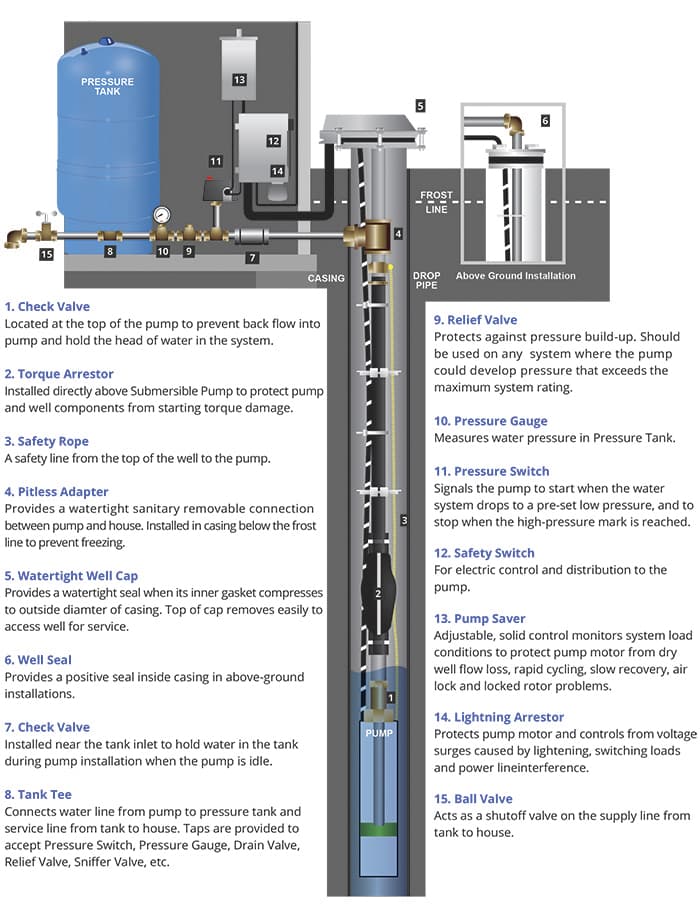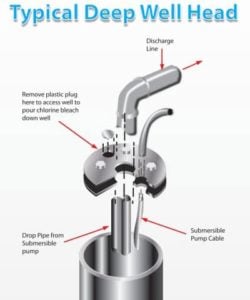 A common question homeowners on well water have is how to shock chlorinate a well.
A common question homeowners on well water have is how to shock chlorinate a well.
A positive test for Coliform bacteria in a well or home piping system indicates that disease-causing bacteria and viruses are likely to be present.
Shock chlorination refers to adding chlorine bleach to your well water to kill bacteria. Read on to learn how to shock chlorinate a well.
If your well has tested positive for coliform bacteria it might indicate that the well is under the influence of surface water, or septic tanks leaking into the well, or the well was not properly disinfected after either being drilled or recently serviced.
Other bacteria such as iron and sulfur bacteria, while not a health threat, can produce obnoxious odors, tastes, and color, and can cause plugging problems in pump and water systems.
Shock chlorination can eliminate the disease-causing bacteria and other nuisance organisms that cause tastes, odors, and slime.
Shock Chlorinate & Sanitize a Well & Home Piping System Whenever:
- A new well has been constructed
- Anytime a well is opened for repairs
- Flood water has entered a well
- A new holding tank, pump or pressure tank has been installed
- A new pipeline or other piping or plumbing work has been done
- Tests indicate the presence of coliform bacteria
- Odors or slime caused by iron or sulfur bacteria are present
How To Shock Chlorinate and Sanitize Wells With Chlorine To Kill Bacteria
It is important to periodically monitor your well to see if contamination is present. The United States Environmental Protection Agency recommends that private water supplies be tested annually for coliform bacteria to detect contamination problems early.
A positive test for coliform bacteria in a well or home piping system indicates that disease-causing bacteria and viruses are likely to be present.
This can mean that the well is under the influence of surface water, septic tanks leaking into the well, or that the well was not properly disinfected after either being drilled or serviced.
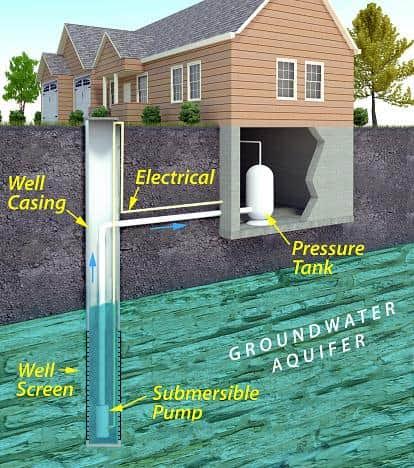
shock chlorinate sanitize wells can eliminate the disease-causing bacteria and other nuisance organisms that cause tastes, bad smells, and slime.
Coliform bacteria tests are used as an indicator of the possible presence of disease-causing bacteria.
You can test for bacteria yourself using a Home Coliform Bacteria test kit, or get a sterile bottle and take it to a lab for a certified test. You can often find a licensed laboratory in your area.
CAUTION: While shock chlorination may correct bacteria and/or odor problems in wells and piping systems in the short term, it does not correct the source of the bacterial contamination.
If bacteria are entering the well from a septic tank or other source, the bacteria will become present again after the well has been sanitized.
Try to identify or trace the source of the bacteria and protect the well itself from contamination.
CAUTION: Shock chlorinate sanitize wells a well may cause the water to turn a dark color and the chlorine may clean the well shaft and pipe of iron and sediment.
The water may initially be very high in sludge and rust and cause damage to pipes and fixtures.
Do not run water high in rust and sediment into water softeners, interior fixtures, water heaters, etc.
Get professional help if needed. Many wells are not easily accessible and you cannot easily add bleach down the well. If you are unsure call your local well driller or pump contractor and arrange professional chlorination and shock treatment.
How to Shock Chlorinate a Well: Which Type of Bleach To Use
The best way to shock chlorinate sanitize wells is to use a combination of dry pellets and dry chlorine granules mixed with water. The dry pellets drop down past the pump and ensure the entire well is sanitized.
In addition, liquid bleach made from potable water grade powdered bleach is poured into the well and then recirculated until the chlorinated water has made its way through the well pipe, pressure tank, and pipes in the house if desired.
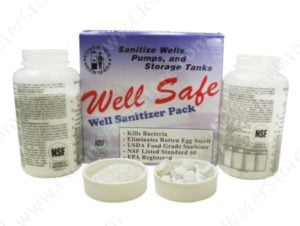
You can use regular household bleach (non-perfumed type) that contains 5.25 percent sodium hypochlorite, which kills bacteria and certain viruses. Laundry bleach can contain contaminants such as benzene and heavy metals so only use as a last resort if you can not find the powdered bleach and pellets.
You can also use pool chlorine, which is 10% to 12% sodium hypochlorite and twice as strong as household bleach. Do not use pool pellets, which are not designed for potable water.
Note of Caution:
Shock chlorinating a well or piping system may loosen up the scale, iron deposits, and other materials, which can clog fixtures, appliances, and valves in the piping system.
Care should be taken when flushing the piping, and all aerators removed to prevent clogging. In some extreme cases of corroded piping, the piping may fail and start to leak after this procedure. Chlorination will not remove nitrate or other contaminants.
How to Shock Chlorinate Sanitize Wells Using Dry Pellets or Powdered Bleach?
The dry pellet method (70% calcium hypochlorite) can be used for well, storage tanks, or cistern sanitation. The number of tablets and granules used will depend on the amount of water in the system to be sanitized. Half of the total treatment will be completed with chlorine pellets and the other half will be completed with granular chlorine slurry.
A 100-ppm chlorine concentration is ideal for sanitizing a well. To produce a 100 PPM chlorine concentration, use 2 oz. sanitizer pellets or granules for every 100 gallons of water in the system. (2oz. granules = 70 Pellets) If the water has a high iron or sulfur content more chlorine may be needed to achieve 100-ppm chlorine residual.
Instructions
1. Bypass the water softener, other filters, or purification equipment. Clean the well house, spring house or storage tank or reservoir. Remove debris and scrub or hose off any dirt or other deposits or interior surfaces. Pump to remove any suspended solids or foreign matter in the water if possible. Scrub interior surfaces of well house with a strong chlorine solution containing ½ gallon household bleach or 0.2 oz of dry bleach granules to every 5 gallons of water.
2. Remove the small well inspection plug on top of the well. For some wells, particularly for wells completed with pitless adapters or buried pressure tanks, there may be a rounded cap that has no inspection hole. Remove the cap or seal from the casing and, if possible, measure the depth of water in the well, then refer to the table below to determine how much sanitizer should be used. You can also estimate well and water depth from well logs or other records.
CAUTION: well caps and seals are integral to the safety and integrity of your well. They are often regulated by state and local codes. Be certain to comply with all applicable codes and licensing laws, whenever opening a well. If you are unsure of any of the following steps, seek the assistance of a qualified or licensed well driller or pump installer, or contractor.
| Well Casing Diameter | Gallons of Water Per 100 Feet | Oz. of Granules to Achieve 100 PPM | Number of Pellets to Achieve 100 PPM |
| 4″ | 70 | 1.3 | 49 |
| 6″ | 150 | 2.9 | 106 |
| 8″– 12″ | 260 | 5.1 | 183 |
| 12″ – 16″ | 590 | 11.6 | 415 |
| 20″ – 24″ | 2350 | 46.0 | 1654 |
| 30″ – 36″ | 5290 | 104.0 | 3724 |
4. Mix the determined amount of granules needed in a clean, plastic five (5) gallon container of water and pour the solution down the well to sanitize the upper portion of the well. Do not add water to product – Add product to water.3. Drop one tablet into the well and listen to hear if the tablet hits the water (you will hear a “plink” sound). If the tablet hits the water, drop the remaining determined number of sanitizing tablets needed into the well.
5. It is necessary to circulate the water in the well to mix the sanitizer thoroughly throughout the entire water system. Connect a hose to an outside sillcock (also known as a hose bib) that is located after the pressure tank and run water back down the well (this also rinses the upper portion of the well).
After approximately 15 minutes of circulating the water, a strong chlorine odor should be present; if not, repeat steps 4 and 5. Run water through service lines until you detect chlorine odor at all taps.
6. Allow the sanitized water to stand in the system for at least six (6) hours, although overnight is preferred. Open an outside faucet and flush system until water runs chlorine-free (no chlorine smell is detected). Repeat flush operation on each faucet in the system.
Do not run high levels of chlorine down the drain into the septic system.
Note:
A) Chlorine may make the water run colored, and iron deposits, slime, and organic material may break loose and plug pump screens.
***DO NOT CONTINUE TO RUN PUMP IF WATER DOES NOT FLOW. ***
B) The high level of chlorine required to sanitize a water system is corrosive to most metals and the chlorine solution must not remain in the water system more than thirty-six (36) hours before completely flushing from the system.
7. Return all equipment to the service position.
8. After the chlorine has been left in the well (and the plumbing system if applicable) for a minimum of 6, up to 12 hours, the chlorinated water can be discharged. Large amounts of chlorinated water should not be discharged into the septic tank, or onto lawns or gardens.
9. If possible, discharge as much of the water as possible through an outside faucet with a hose attachment. Do not discharge the chlorinated water into streams or rivers. The small amount of chlorinated water, which remains in the household plumbing, can be discharged into the septic system.
The water should be tested 2 to 3 weeks after sanitizing. If bacteria, iron bacteria, sulfur, or other problems recur, contact your water professional for further treatment.
(If you want to read more about Chlorinate Sanitize Wells, check out this post)
Shock Chlorinate Sanitize Wells: Shock Chlorinate a Well Using Liquid Chlorine Bleach:
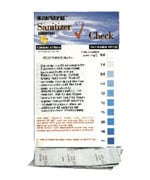
1. Clean the well house, spring house or storage tank or reservoir.
2. Remove debris and scrub or hose off any dirt or other deposits or interior surfaces.
3. Pump to remove any suspended solids or foreign matter in the water if possible. Scrub interior surfaces with a strong chlorine solution containing ½ gallon household bleach to every 5 gallons of water.
4. Determine how much chlorine to use to disinfect your well by consulting Table 1. If you don't know the well depth, contact your well driller as they often keep records that will show the depth of the well.
See the chart below to find out the amount of 5% chlorine bleach (sodium hypochlorite) needed for disinfection to obtain approximately a 100 ppm chlorine solution in the well.
If using pool chlorine (10% to 12% sodium hypochlorite) use half as much chlorine bleach.
| Well Casing Diameter | Distance From Water Level to Bottom of Well (Water Depth) | |||||
| 0′ – 50′ | 50′ – 100′ | 100 – 200′ | 200′ – 300′ | 300′ – 400′ | 400′ – 500′ | |
| 4″ | 8 oz | 16 oz | 24 oz | 1 qt | 1 ½ gal. | 2 gal. |
| 6″ | 1 qt | 2 qt. | 1 ½ gal. | 2 gal. | 2 ½ gal. | 3 gal. |
| 8″– 12″ | 1 gal. | 1 ½ gal. | 2 gal. | 2 ½ gal. | 5 gal. | 6 gal. |
| 12″ – 16″ | 1 gal. | 2 gal. | 4 gal. | 6 gal. | 8 gal. | 10 gal. |
| 20″ – 24″ | 2 gal. | 6 gal. | 10 gal. | 14 gal. | 18 gal. | 22 gal. |
| 30″ – 36″ | 6 gal. | 10 gal. | 20 gal. | 30 gal. | 40 gal. | 50 gal. |
EXAMPLE: The well is 4″ in diameter, with a depth of 400 feet. The water level is 100 feet below the surface. 400 – 100 = 300 feet. Use 1 ½ gallon of household bleach.
NOTE: In applications where it is inconvenient to determine water depth, at least ½ gallon of household bleach, or ¼ gallon of pool chlorine, may be used for wells up to 8″ in diameter with water estimated to be less than 80 feet deep; one gallon should be used for similarly sized wells with water greater than 80 feet.
5. Mix the chlorine solution above with 10 times as much water before pouring down well. Avoid pouring strong bleach down the well.
6. Open the well cap, or if your well has a well top seal, remove the ½” plug or air vent and use a large funnel to pour chlorine down well. CAUTION: well caps and seals are integral to the safety and integrity of your well. They are often regulated by state and local codes. Be certain to comply with all applicable codes and licensing laws, whenever opening a well. If you are unsure of any of the following steps, seek the assistance of a qualified or licensed well driller or pump installer, or contractor.
7. Do not attempt to remove the sanitary well seal without the assistance of a qualified well driller or pump contractor. Do not loosen the bolts that compress the seal.
8. Wells equipped with a packer jet pump can be thoroughly disinfected only through the removal of the pipe, pump and jet unit from the well.
9. As you are adding the chlorine solution, take precautions to protect yourself from splashing chlorine and fumes. Protect your eyes with safety goggles, and wear protective gloves and clothing.
10. Pour the chlorine solution down the well. Avoid pouring the chlorine solution on the pump wire connectors. If in doubt, use dry chlorine pellets.
11. If the well is relatively deep, the disinfectant may be dispersed to the bottom by alternatively starting and stopping the pump several times (although dry pellets work better for this reason). If possible, place a garden hose in the top of the well, and turn on the faucet and circulate the chlorine solution for 15 minutes until a strong 50 ppm chlorine residual is detected, by using a chlorine test kit.
12. Add more bleach as needed to bring up the chlorine solution residual in the well to 50 to 100 ppm.
13. If possible, circulate the water from the well by connecting a garden hose to a nearby hose bib or sill cock, and feed the water back down into the well. This will also wash down the sides of the well and ensure proper mixing. After approximately 15 minutes a strong chlorine odor should develop. To be more precise use a chlorine test kit to make sure the chlorine is over 50 ppm.
14. Water should be pumped from the well into the pressure tank and plumbing system.
15. All water faucets should be turned on in the house and all outside fixtures and hose bibs including fire hydrants, watering troughs, and other supply lines to other buildings, until a 50 ppm chlorine residual is detected.
16. After the chlorine has been left in the well (and the plumbing system if applicable) for a minimum of 6, up to 12 hours, the chlorinated water can be discharged. Large amounts of chlorinated water should not be discharged into the septic tank, or onto lawns or gardens.
If possible, discharge as much of the water as possible through an outside faucet with a hose attachment. Do not discharge the chlorinated water into streams or rivers. The small amount of chlorinated water, which remains in the household plumbing, can be discharged into the septic system, but first, flush the water.
18. Backwash water softeners; flush the water heater, and replace all filters if present.
19. For wells and piping systems that have bacterial contamination or have been flooded, re-sample the water and retest for coliform, after all the chlorine residual, is gone.
20. The water should be tested 2 to 3 weeks after sanitizing. If bacteria, iron bacteria, sulfur, or other problems recur, contact your well water professional for further treatment.
NOTE: For heavily iron-fouled wells, severe contamination with biofilms or slime, or excessive levels of hydrogen sulfide gas, apply a 100 ppm or 200 ppm residual by multiplying the chlorine bleach used by 2 or 4 times.
Well System Diagram
Wells with submersible pumps have pipes that either enter through the top or through the side. Many wells are underground or in vaults in areas with freezing temperatures.
Frequently Asked Questions How to Shock Chlorinate a Well
What Precautions Should I Take Before A Chlorination is Started?
If you are not familiar with your well or well construction, or how to shock chlorinate a well, consider hiring a licensed well driller to shock chlorinate.
Should you decide to shock chlorinate your well yourself, take the following precautionary measures:
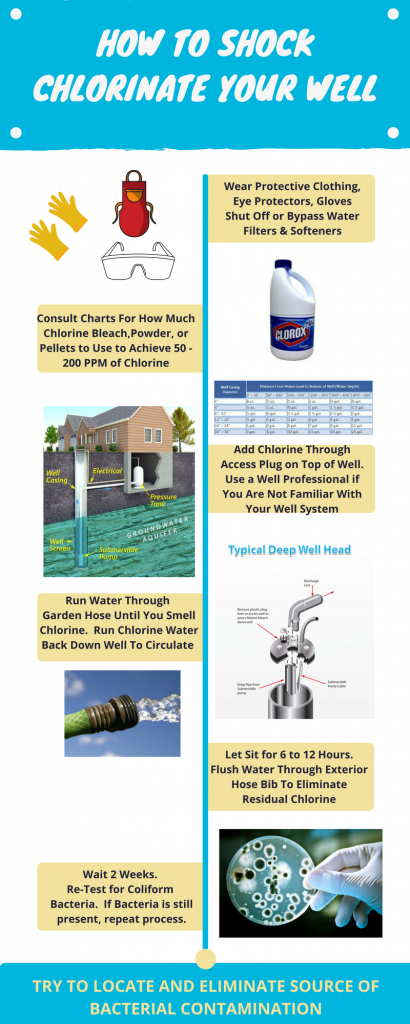
2. Mix and add chlorine solution in a well-ventilated area. High chlorine levels in water after shock chlorination. Make sure that your family or pets do not use the water during the chlorination process.
3. Preventing electric shock from the water pump. Before removing the well cap or cover, turn the pump circuit breaker off. Wear waterproof rubber boots.
4. Shock chlorinating your water supply system can potentially damage your pressure tank, some filters and filter media, or water softener, so bypass these systems if possible.
5. Before you begin, shut off water to all carbon filters and reverse osmosis units attached to your household water lines, and bypass water softener or iron filter.
When Can I Use the Water Again?
Make sure to flush 4 well volumes before using the water:
4” well diameter has 70 gallons per 100 ft of depth
6” well diameter has 150 gallons per 100 ft of depth
8” well diameter has 260 gallons per 100 ft of depth
Wait for one to two weeks after shock chlorinating the water supply system and then retest for total coliform and E. coli bacteria.
If the test results show the absence of coliform bacteria, the water is safe to drink.
However, if test results show the presence of coliform bacteria, the source(s) of contamination should be identified and eliminated through a licensed well driller/contractor, or a continuous disinfection treatment system should be installed.
What Type of Chlorine Bleach Should Be Used?
For best results use powdered bleach or pellets that are certified for drinking water. However, it is also OK to use unscented household chlorine bleach with at least 5% sodium hypochlorite found in supermarkets.
See the EPA resource for home water wells: https://www.epa.gov/safewater/pwells1.html
Email our technical support department at support@cleanwaterstore.com or call us for help at 1-888-600-5426!
Consider a home chlorination system to keep your well water disinfected.
See all our well water treatment systems

